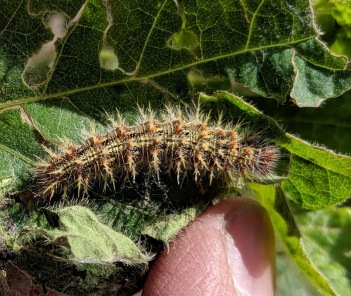June 17: CSI for Youth: Focus on Soybeans, 5 p.m., RSVP jrees2@unl.edu
June 18: Wheat and Pulse Crop Field Day, 9 a.m.-4 p.m. ENREC near Mead, RSVP: 402-727-2775
June 18: West Central R&E Center Wheat Tour, North Platte, RSVP: 308-696-6783
June 19: Irrigation Scheduling to Save Money in Wet Years, Noon-1:30 p.m., Leadership Center, Aurora, RSVP: 402-694-6174
June 19: Wheat, Pulse, Canola Tour, all day, Henry J. Stumpf International Wheat Center near Grant, RSVP: 308-352-4340
June 20: Wheat Variety Tour, 5 p.m., near Alma, RSVP: 308-995-4222
June 20-21: Tractor Safety Training, Fairgrounds, Wayne, (402) 375-3310, https://go.unl.edu/mcyy
June 25: Keep Rural Worksites Strong Mental Health Workshop, 9 a.m.-4 p.m., Seward Family Medical Clinic, $20, RSVP: 877-337-3573
June 25: Irrigation Scheduling to Save Money in Wet Years, Noon-1:30 p.m., Chances R, York, RSVP: 402-694-6174
June 26: SCAL Weed Science Field Day, 8:30 a.m.-1 p.m. (Reg. 8 a.m.), South Central Ag Lab near Clay Center, http://agronomy.unl.edu/fieldday
Crop Update: This past week’s top question was about yellow looking and/or buggy whipped corn and weed control. Much of what we’re seeing can be attributed to cool, wet conditions this spring. Yellow striping on leaves is often due to sulfur deficiency but could be combined with other nutrient deficiencies depending on conditions. Purdue University has a nice guide with pics if you’d like to check it out: https://www.agry.purdue.edu/ext/soilfertility/news/Striped_Corn.pdf.
Most of what I looked at or received questions about was yellow and/or buggy whipped corn due to herbicide injury. This isn’t uncommon for pre-plant residual herbicides to impact corn more in years where we have wet conditions, cooler temps, and plants that are slower to emerge/grow. Yes, some of these products are considered ‘safe’ for corn, and they shouldn’t kill it. It’s just we’re experiencing a strange year with cool, wet conditions and the corn is metabolizing the chemical but not growing fast enough, thus the injury. Situations which may be extra sensitive are ones in which corn was planted too wet with slots not closing or if corn was planted too shallow. Soil applied grass herbicides and those with pre-mixes containing atrazine may be experiencing more of the buggy whipping or yellowing from Group 15 growth inhibitor herbicides. Yellow/purple leaves and sometimes ‘bottlebrush’ looking roots can be exhibited from Group 2 ALS-inhibitor herbicides. Herbicides in Group 27 with ‘bleacher’ chemistry are re-activated with rain events and we’re seeing some yellow/white corn and milo due to that. Dr. Kevin Bradley, University of Missouri, wrote an article that shares photos and trade names if you’re interested in checking that out: https://ipm.missouri.edu/IPCM/2009/4/Cool-Wet-Soils-Can-result-in-More-Corn-Injury-from-Preemergence-Residual-Herbicides/. I realize it’s frustrating, but overall these are good products and it’s the weather conditions causing the problems. Each day of sunshine and warmer temps are helping corn to grow out of the symptoms and look greener/healthier in most cases.
The other concern is the rain has moved herbicides down into the soil and we’re beginning to see weed flushes of waterhemp and palmer on the soil surface. Chris Proctor, Extension Educator, addressed this in CropWatch and Nebraska Farmer as we think of post-emergence control right now in both corn and soybean. There are additional trade names with similar chemistries mentioned and this isn’t an endorsement of specific products. “There are a number of effective herbicide options in corn such as Acuron, Laudis, or Diflexx Duo. In soybean, herbicide options are much more limited. When coupled with traited seed, Liberty, or Xtendimax can be effective at controlling these weeds postemergence, and in a Roundup Ready system Warrant Ultra or Flexstar GT are good options. It’s not too early to plan how to improve weed control in fields with a history of difficult-to-control weeds. A good preemergence herbicide program, use of narrow row-spacing, and even cover crops, when used as part of an integrated management plan, can improve control of herbicide-resistant weeds.”
Thistle Caterpillars: Painted lady butterflies migrate north from the southern U.S. and

This caterpillar still has several weeks (2-5 depending on weather) of feeding.

This caterpillar will begin pupating within a week.
Mexico each spring. The butterflies have been around for a little over a month and thistle caterpillars have been found feeding in soybean the past few weeks. Last week, I was seeing higher populations in early planted soybeans in Clay and Nuckolls counties. Larvae can feed from 2-6 weeks depending on weather. Treatment thresholds for vegetative stages are 30% defoliation. Each field needs to be assessed regarding percent defoliation and larval stage. Some fields I checked had larvae that were pupating or already emerged as adults. Other fields had larval stages that will still feed 2-5 weeks, depending on weather. Much information we read says they stay on field borders, which I’ve seen to be true later in the growing season. But right now, I’m finding situations where they’re fairly consistently infested throughout the field. Some may consider adding an insecticide to your post-herbicide application. If you have dicamba-tolerant soybeans, be sure to check the product’s website regarding approved tank-mix partners.
Irrigation Scheduling Workshops for wet years will be held Wednesday June 19th, 12 noon, at The Leadership Center, 211 Q St (E Hwy 34) in Aurora and Tuesday June 25th, 12 noon, at the Chances R Restaurant, 124 West Fifth Street, York. The program will start with lunch at 12:00 pm, followed by the speakers and wrap up around 1:30 pm. The Upper Big Blue NRD will provide the lunch. RSVP is not required but appreciated for a meal count. Call the Hamilton County Extension office at 402-694-6174 or email Steve Melvin at steve.melvin@unl.edu. Dan Leininger with the Upper Big Blue NRD will speak on installing sensors and Steve Melvin will speak on deciding when and how much water to apply using watermark sensor readings.


































